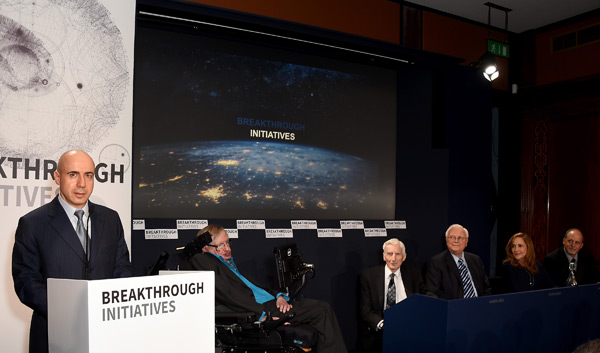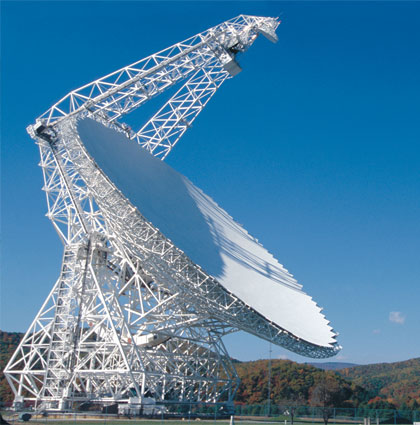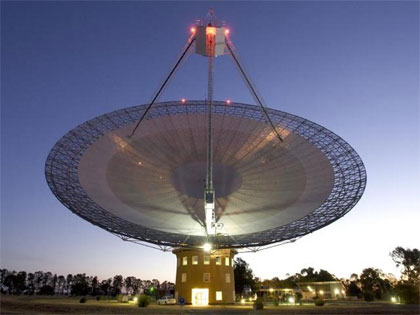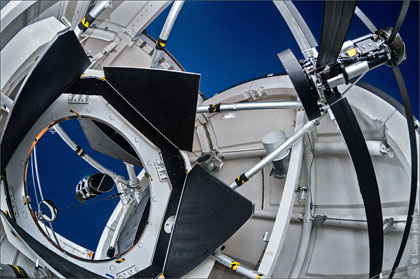A $100 million donation will radically speed up the search for artificial signals from the nearest million stars — and from trillions of much farther stars in the 100 nearest galaxies.

Fascination with SETI — the search for extraterrestrial intelligence — waxes and wanes in cycles. Are other technologically able creatures broadcasting their existence to the stars? It's the most important question we know about our role in the cosmos and humanity's long-term future. Are we merely like ants, hopelessly outclassed by vastly older, superior species among the stars? If so, will they help us, harm us, or ignore us? Or are we alone, holding in our own hands the future of conscious life itself?
On July 20th, in an announcement at the Royal Society in London, a tech billionaire and a group of eminent scientists announced a great leap forward in the search to find out. Russian investor Yuri Milner announced that he is committing $100 million to the Breakthough Prize Foundation to carry out radically ambitious SETI projects for the next 10 years, under the name Breakthrough Listen.
"It's just a miracle," SETI pioneer Frank Drake told the New York Times. Said Dan Werthimer, longtime SETI researcher at UC Berkeley and originator of the SETI@home project, "This is beyond my wildest dreams."

The team that Breakthrough Listen has assembled, drawing on UC Berkeley's Search for Extraterrestrial Intelligence Research Center, plans to use about a third of the money to buy some 20 percent of the time on the 100-meter Green Bank radio telescope in West Virginia, as well as substantial time on the 64-meter Parkes radio dish in Australia, for 10 years. These purchases will help ensure a future for both financially imperiled telescopes. Other radio telescopes may be added.
Another third of the funds will go toward developing powerful, sensitive, new receivers and processors to examine billions of narrow frequency channels from 1 to 10 gigahertz. This range spans most of the best radio frequencies: those that get through Earth's atmosphere and are not swamped by cosmic background noise. No protracted search has ever successfully covered such a wide band.
The radio project will use two opposite search strategies. The first is a "targeted search." We now know that most stars have planets. The telescopes will examine the nearest 1 million stars in case radio-emitting civilizations are relatively common — meaning they currently inhabit more than one in a million solar systems — but in case none broadcasts its existence to the cosmos at terribly high power. Looking even closer, the Breakthrough Listen team claims that the project would be able to hear an ordinary air-traffic control radar continuously aimed our way from the nearest thousand stars.

On the other hand, many who have studied SETI search strategy conclude that the most prominent alien signals in our sky are likely to be from extremely powerful transmitters extremely far away. So a "wide sky" sweep is more likely to succeed than a targeted search of individual stars nearby. The logic behind this conclusion seems impeccable even if we know nothing about alien civilizations or their technologies.
To cover this possibility, Breakthrough Listen will also sweep the plane of the Milky Way and the galactic center to encompass more than 100 billion stars in shallower listens. And it will take protracted stares at 100 of the nearest galaxies to cover tens of trillions of stars much farther still. Just one very old supercivilization among all these stars, choosing to display its existence to the cosmos with sufficiently extreme power, would answer the question of whether we're alone right away. Failure to find one would be real evidence that supercivilizations of this kind don't exist.

Breakthrough Listen also plans to carry out an optical SETI search. This project will enhance the sifting of spectroscopic data from Lick Observatory's 2.4-meter Automated Planet Finder telescope (at left) to carry out the deepest search yet for continuous laser signals that might be aimed at our solar system from specific stars under study.
All these projects will gather vast amounts of raw data. Some of its analysis will probably be farmed out to volunteers donating their computers' spare time by way of an app such as SETI@home, which began analyzing data from the Arecibo radio telescope in 1999 and continues going strong today.
Also announced on Monday was Breakthrough Message, a $1 million open competition for ideas about what, if anything, Earth should transmit if Breakthrough Listen finds another civilization. Breakthrough Initiatives says it will not transmit any message until after a global debate on whether calling extra attention to ourselves this way is a good idea.
SETI's Long Perspective
But don't get your hopes up too soon. The Breakthrough Listen planners claim that they'll speed up the search for intelligent life by 100 times over current and recent searches. That's a big improvement, but settling the question of whether we're alone is likely to take generations. The "search space" to be sifted is enormous: many billions of radio, infrared and optical frequencies at each one of many billions of locations on the sky. And then there are such complications as intermittency, frequency drifts, and other factors. In 2004, Guillermo Lemarchand (University of Buenos Aires) calculated that all the SETI searches up to then had scanned only one hundred-trillionth (10–14) of the cosmic haystack that's waiting to be searched for the needle of an artificial signal.
Scientists with careers to build, and funding agencies with donors to satisfy, prefer to see a return on investment in years or decades, not centuries. So enthusiasm for SETI waxes and wanes, with each new wave of fascination being followed by disillusionment with the boredom of seeing no results. Humanity isn't yet good at projects with very long time horizons.
But for SETI, Breakthrough Listen will help pave the way to getting there.
Video highlights of the press conference (7:15).
UC Berkeley News article, listing some of the personnel.
A Breakthrough Initiatives backgrounder about SETI and our place in the universe, drawing from the Cosmos TV series (1 hour 30 minutes):
 6
6









Comments
Peter Wilson
July 21, 2015 at 8:30 pm
"Looking even closer, the Breakthrough Listen team claims that the project would be able to hear an ordinary air traffic control radar aimed our way from the nearest thousand stars." Cool. Maybe awesome.
"On the other hand, many who have studied SETI search strategies conclude that the most prominent alien signals in our sky are likely to be extremely powerful transmitters extremely far away."
Huh? Humans do not transmit extremely powerful signals. Why should we expect aliens to? Also, responding to transmitters extremely far away would take an extremely long time. Humans do not engage in projects that require a 30,000 year wait. Why would aliens?
You must be logged in to post a comment.
Karl
July 22, 2015 at 1:35 am
“On the other hand, many who have studied SETI search strategies conclude that the most prominent alien signals in our sky are likely to be extremely powerful transmitters extremely far away.”
The power required to be detectable increases with the square of the distance, but number of potential transmitters goes up with the cube. It's the same reason most of the stars we see are rare, exceptionally bright ones - even though they're vastly outnumbered by red dwarfs.
"Humans do not transmit extremely powerful signals. Why should we expect aliens to?"
Unless the typical lifetime of a transmitting civilization is extremely short (in which case SETI is probably doomed from the start) we must be one of the youngest. So anyone we hear from will probably be far more advanced, and transmitting powerful signals is likely to be far less expensive for them - if they want to do it.
"Humans do not engage in projects that require a 30,000 year wait. Why would aliens?"
Who knows? Maybe the signal was aimed at someone closer and we are in line with the spillover. Maybe they aren't looking for a response. A transmission might be a sort of monument... humans won't wait 30,000 years for a response, but we do build pyramids. And we've already sent 2 transmissions of that sort ourselves. Or maybe they really do wait - for example, send out a bunch of messages and go to sleep until awakened by an answer.
You must be logged in to post a comment.
Anthony Barreiro
July 22, 2015 at 7:07 pm
We know absolutely nothing about life beyond the Earth, starting with our complete ignorance regarding whether or not any living beings, intelligent or not, exist beyond our own planet. Therefore exobiology in general and SETI in particular are perfect blank screens onto which we project our own conscious and unconscious assumptions, hopes, and fears. The universe may be teeming with life, or Earth may be a rare fluke. Aliens may be highly advanced beings who will help us evolve into perfect enlightenment, or evil overlords who will enslave and destroy us. Or whatever else your heart desires or abhors.
The best thing about this initiative, in my humble opinion, is that it will help keep Green Bank, Parkes, and Lick operating and available for other studies with stronger (i.e. greater than zero) empirical foundations.
And I will happily be surprised if we do detect an unambiguous signal from an intelligent alien civilization. I wonder if they will be more like Yoda, or more like Spock.
You must be logged in to post a comment.
Gordon
July 22, 2015 at 11:42 pm
We have no clue what to look for so any search improves the detection odds.
It is true the current strategy by SETI would not find our most powerful TV stations, as they look like noise, nor our most powerful radar as they use pulse compression, so are not at any one frequency. All of our current high power and high use radios have a use range of under a couple of milliseconds(200 miles). This will increase as we spread out in the universe, but Repeaters seem more likely useful.
You must be logged in to post a comment.
July 25, 2015 at 8:58 am
I've been wondering for a long time about how our shift away from high power radio frequency transmissions on Earth might reduce the chances of discovering a message from interstellar space. When I was a kid (50 years ago) shortwave radios could tune into broadcasts from around the world. Today those receivers are slowly going silent as we move away from powerful broadcasts and into fiber. I’m thinking any advanced civilization would go through the same process and switched to alternate methods of communications. Taking this into consideration, wouldn’t this reduce the chances of intercepting an interstellar communication by 100 years of powerful transmission / 10,000 years of intelligent non-electronic communications or 1% of our projection?
You must be logged in to post a comment.
Alan MacRobertPost Author
July 27, 2015 at 10:09 am
Realistically, we have no ability to detect "leakege" of signals from an exoplanet's internal communications, nor will we in the foreseeable future. What we're looking for is a "beacon signal," a deliberate broadcast to the universe designed for others like us to discover.
--Alan MacRobert/ Sky & Telescope
You must be logged in to post a comment.
You must be logged in to post a comment.